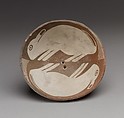Bowl with Two Rabbits
Not on view
Although representational images made on materials of many sorts—for instance, stone, wood, and leather—are believed to have been produced in the Southwest for thousands of years, the custom of putting such images on ceramic vessels became common only after the middle of the first millennium A.D. Fabricated from fired clay, the ceramic vessels were primarily utilitarian bowls and jars used in domestic contexts for the preparation and storage of food. Their production had been established in the area a few hundred years earlier. However, once elaborated with painted surfaces on the inside, the round-bottom bowls became a much favored Southwestern form, used not just for utilitarian purposes. Many, many hundreds of vessels were produced by a variety of different peoples. Ninth- to twelfth-century bowls from the Mimbres Valley of New Mexico are particularly distinctive in their interior decoration, with images of animals native to the Southwest. The rabbit, actually a food animal to the peoples of the Mimbres Valley, was a frequent motif. In pairs or singly, rabbits appear in a range of stylized renditions, from plump bunnies, as here, to elongated animals with winglike ears.
Due to rights restrictions, this image cannot be enlarged, viewed at full screen, or downloaded.
This artwork is meant to be viewed from right to left. Scroll left to view more.



